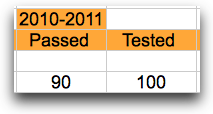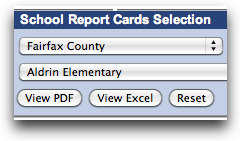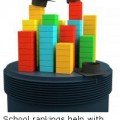Have you ever heard the saying “throwing the baby out with the bathwater”? Legend says that in the past, families only bathed once in a while – and every member of the family got to do it inside the same tub of water.
Dad had the first turn, then Mom, then the kids, and lastly – the baby. By then, the water was not exactly clear and it was easy for whomever was throwing the water out not to see the baby in it.
When you are choosing a school, if you aren’t looking at the important points, you might very well be missing them; and throwing out the opportunity to have your kids attend a good school – and buying the dream home for your family.
Some of the mistakes you could make when choosing a school relate to exclusively using one source of information to assess how “good” a school is.
For example, many people rely only on the information provided by GreatSchools* to compare schools
GreatSchools is an independent website which aims to give parents the tools to be able to compare schools side by side and make an informed decision of whether a school is good for their needs. GreatSchools mainly offers two kinds of information about schools to parents:
1. GreatSchools Ratings
2. GreatSchools Reviews
1. Greatschools Ratings
When looking through GreatSchools, you can find a big, red graphic with a single digit next to the name of each school. These single-digit numbers go from 1 to 10, with 10 signifying a better school than the one with a grade of 1. By digging a little deeper, you can find that these single-digit numbers have been calculated by GreatSchools based on the State’s Standard of Learning Scores.
In this case, we are talking about the Virginia Standard of Learning Scores (SOL). The SOLs are standardized tests that all children must take every year and the result of these tests is a number from 0 to 100 representing the percentage of children who passed the test.
This way, the Virginia Department of Education is able to average out these passing percentages to identify the overall passing percentage of a grade (e.g. 5th grade), a demographic (e.g. hispanic students), a school, a division (e.g. Fairfax County Public Schools), and the State.
In Virginia, the overall SOL pass rate is 88, and the “division” of Fairfax County Public Schools is 92.
So, what is the problem with using Greatschools single-digit rating?
The first problem that I found is that I couldn’t correlate the single-digit to the actual SOL score. I first compared the single digit, say “8” to the last digit of the SOL average for a school. In some cases, it matched (i.e. The school’s average SOL score was “98”). But it was inconsistent. Some schools which had a single digit rating of, for example: “4” did not have an SOL average score of “94”. I averaged the passing rates across the 3 school-years of scores reported on the spreadsheet, but that didn’t match. Next, I averaged only the “Math” scores, only the “Reading” scores, and a combination of all the scores that I could find on the sheet and I still couldn’t make them match.
What I found is that GreatSchools’s ratings are more art than science
The issue with the ratings being more art than science is that this makes it difficult to make an informed decision. How can you know which school is better than another one when you don’t understand how they’re being rated?
So how can you find reliable ratings?
To make a decision based on a reliable rating, you can go directly to the official source of SOL scores – the Virginia Department of Education, where you can find detailed spreadsheets on pass/fail rates for every school, every grade, every subject, and every demographic.
But looking only at test scores can tell you whether a school is good -on paper-, so how do you know what the real-life environment is like? For this, many people rely on reviews. GreatSchools offers reviews which can be written by anybody – parent, teacher, student, and even someone without any ties to the school. However, relying exclusively on GreatSchools’s Reviews can be another mistake.
2. GreatSchools Reviews
We are so used to relying on reviews for purchasing stuff on the Internet that it’s easy to translate that trust to other reviews. The difference is that, on Amazon, for example, the most popular products have hundreds – if not thousands of reviews. And on top of that, there is a system for voting for the “most helpful” reviews so that they rise at the top (not that these reviews are perfect either, but you can see a trend).
The difference between Amazon and GreatSchools is that most schools only have a handful of reviews (at least in Fairfax County). With hundreds of children attending a school each year, and the ability for students, parents, and everyone else to provide a review – a handful is hardly a representative sample of what the school environment is like. Further, in some cases, one disgruntled person can post as many reviews as s/he wants, therefore biasing the few reviews available.
All this to say that I think GreatSchools is, indeed, a good site
GreatSchools is a valuable website with good information. It’s just that choosing a school based only on the GreatSchools ratings and reviews, causing you to disregard some great homes to purchase, could be like throwing the baby out with the bathwater. This almost happened to some recent clients of mine –
Charlie and Jackie almost missed out on a great home
Let’s look at the example of some recent clients of mine (let’s call them Charlie and Jackie) who were home-shopping from out of town. They had done their homework and had selected several elementary schools and a few homes within their boundaries to visit. So, we were out looking at homes and I mentioned to them another area which could meet their needs. We found a house on the MLS which met all their criteria – and the only thing left to do was to check if the assigned school met their criteria as well.
The results from GreatSchools weren’t promising
Jackie checked GreatSchools and came back sad because the GreatSchools single-digit rating for that school was a “4”. She thought that this meant that it was a 4 out of 10 (and that doesn’t look very good as it points to a below-average rating). Then, she looked at the reviews and there were 13 of them. Several reviews were negative and revolved around a specific theme.
I asked Jackie to check the official School Report Cards
I asked Jackie if she had looked at the Virginia Department of Education “School Report Cards”, and I pointed her to the State government website where she could download the specific spreadsheet. After looking at the official spreadsheet, she found that the school had scored a 94 out of 100. And the average SOL pass rate for the entire Fairfax County is 92 (Virginia’s is 88). Certainly, 94 is above average and is not the poor “4 out of 10” that she came to believe at first.
Jackie also evaluated the validity of the reviews
After she looked at the SOL scores, I asked Jackie to evaluate whether the reviews were valid or if they were perhaps written by a few disgruntled people. And even if there were several disgruntled people, we wondered if 13 total reviews (8 negative ones) were enough to give her the big picture of the school environment with over 800 kids enrolled in the 2011-2012 school year. To get a better understanding of the school environment, Jackie also got information from neighbors with kids in the school who gave her a different view from what the GreatSchools’s negative reviews said.
Charlie and Jackie made a decision armed with enough information
Happily, Charlie and Jackie were satisfied with the new info they had found and decided to make an offer on the home they really liked – because the school did meet their criteria after all.
Are these the only two ways to choose a school?
You may think that choosing a school based only on reviews and SOL scores doesn’t necessarily mean that it’s the right school for your children. And you are right. Reviews are very subjective. You would have to have enough of them to see a trend.
And SOL scores are only one way to compare a school with another. There are several reasons why a school might be better over another for your specific needs. Some of the reasons could be the size of it (by enrollment), the special programs offered, and even the grades offered. All of this information is publicly available on the official Fairfax County Public Schools website.
Here are a few public sources of information that you can access to make an informed decision
Now you know of other sources of information that you can access to get a better picture of any school that you are considering for your children:
1. The Virginia Department of Education “School Report Cards” – for detailed SOL pass/fail rates
2. The Fairfax County Public Schools website– for information on special programs, enrollment, grades offered, etc.
And yes,
3. The GreatSchools website– where you can find other juicy bits of info to help you make an informed decision.
Next Step
Do you have any other sources of information that you have used to help you decide which school is the right one for you? Please, do share them below. Other home-buyers will thank you. 
*The GreatSchools name is a registered trademark of its owner.










 Everybody is welcome to find a home by school boundary. A school boundary
is simply a geographical area, just like a zip code or a postal city.
Everybody is welcome to find a home by school boundary. A school boundary
is simply a geographical area, just like a zip code or a postal city.
 Does anything on this website bug you? Nothing is too small or too big. If there is something we can fix, we'd love to know.
Does anything on this website bug you? Nothing is too small or too big. If there is something we can fix, we'd love to know.


The greatschools review system lacks proper integrity. I have found dozens of accounts online of how GreatSchools.org arbitrarily removes negative reviews from their site. I would not trust this site to give you a trueful account of parents opinions.
Thanks for your comment, Logan.
I would certainly expect to be able to trust a website with school reviews. Let’s hope that GreatSchools is not deleting negative (but real) reviews.
Parent reviews have nothing to do with a schools rating.
While I can’t attest to the removal of negative reviews, I can say that, like most areas in life, the people who post reviews tend to be complainers.
I like the negative reviews, especially of higher performing schools (I wouldn’t consider a school rated lower than 9). They are usually complaints against the office staff or too much homework. I’ll be straight, I’m glad those folks take their kids out of higher performing schools for reasons like these. I don’t want me kids around their kids. I want me kids around kids who are more likely to succeed in life.
Greatschools.org ratings are fantastic. The site’s ratings provide a school-wide rating compared to other schools in the metro area (1-10). More importantly, it tells you what percentage of each grade’s students earned passing scores for the last few years in key subjects (e.g., Math, Reading, Writing, Science).
By implication, and maybe more importantly, it also tells you the kind of peers your children will have. Having had kids go to schools with overall ratings of 6, 8, and 10, I would never again send my kids to a school rated less than a 9–for academic and social reasons. We live in a “9” community, but are thankful that our kids attend one of the handful of “10”-schools nearby.
No school is perfect, but there are far more kids in lower-rated schools who are dealing with abuse and overexposure to sex and drugs and have parents who don’t value a strong education. These kids influence your kids and more-likely-than not expose your kids to stuff they shouldn’t be exposed to before the age of 13.
Yes, there kids in “10” schools with these kinds of problems, but not in comparison to lower rated schools. The bigger problem in “10” schools is spoiled kids, but I would rather deal with that problem than others.
Hi Ben,
Thanks so much for your thoughts. I agree with you that having a higher rating is potentially better than a lower rating.
My concern is how those ratings are calculated. If GreatSchools ratings are to be trusted, in my opinion, they should be transparent and clearly explain how they come up with their “10” (or “5”) rating.
Their ratings are based off of standardized test scores. Schools are rated 1 to 10 (with 10 being the highest) as follows: The top 10% performing schools in the “area” (usually the state) get a 10, and so on. Further, the site often gives you grade by grade break downs.
People complain about standardized test scores, but these tests should be easy to pass, as in, you’ve got a real problem if say 10-15% of the students can’t pass a grade level reading or math standardized test.
Having sent my kids, at one point to a “6” and an “8” school, I would never do it again. The low educational expectations and the higher quantity and severe quality of problems of other kids at the school the farther you get from 10 are not good.
I think you’re giving too much credit to a “10” school and overestimating the “damage” a “6” school could do to a kid’s education. I taught at a 10 school for over a decade, and it becomes clear after a while that that the greatest single impact on a student’s test score (the only thing factored into the greatschools.org ranking) is the child himself/herself and their family. The work we did as teachers had some impact, but trust me when I tell you that I saw plenty of teachers with low standards for the students in my highly ranked school.
What about a school that does a fantastic job teaching kids but works with lower-middle class students? Perhaps due to their student population, that school would have been a “4” with average teachers and administration, but they achieve a “6” with their great staff. Just imagine what they could do with your child that comes from a family that values education. Unfortunately, that’s not factored into the greatschools.org ranking.
Planet Money recently did a great episode on correlation vs. causation, and they tackled this exact topic (standardized test scores in “low rated” schools).
http://www.npr.org/blogs/money/2013/04/23/178635250/episode-453-what-causes-what
I agree almost completely. Parents (and kids) are 90% of it. However, if you have properly supportive parents and a child who is capable of doing grade level work, a “6” school–because of its typical student population–will almost always be teaching its students at least 1 year below the already low grade level standards.
Plus, kids succumb to peer pressure, and since the quality of the ethics/morals/traumatic life experiences of kids at a “6” school, on average, is much lower than at “10” schools, you are putting your child in unnecessary risk.
Can a child overcome that? A small number of exceptional children might, but not most. And why, if you can do otherwise, would you put your kid in such a situation? Such kids often end up at Ivy League schools because they endured hardship and excelled.
Hi Ben,
Thanks for clarifying that GreatSchools’ ratings are based on a school’s passing rate and the decile in which they fall within an “area”. Would you have a link for reference, please? I’d like to research it further and update the article.
Specifics concerning the rating (1-10) that each school gets can be found at http://www.greatschools.org/about/ratings.page
Recently, the site hyperlinked the above link at the bottom of each page, where it says, “How we rate schools”